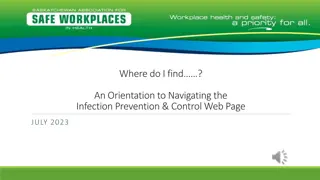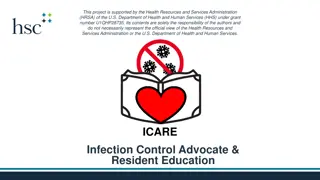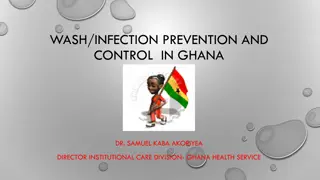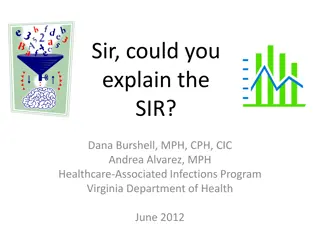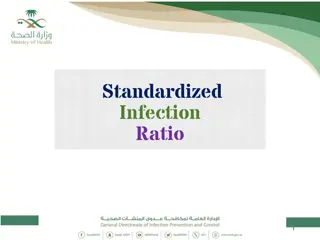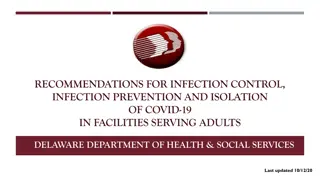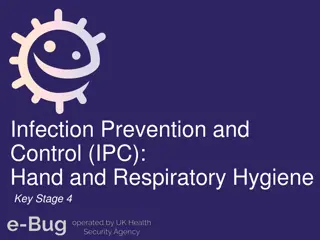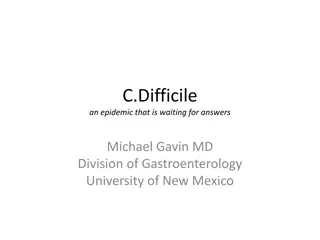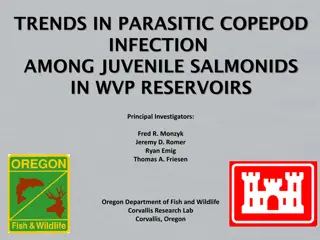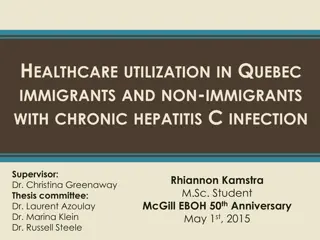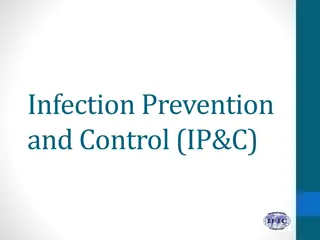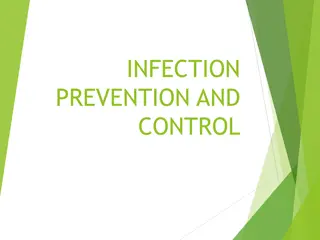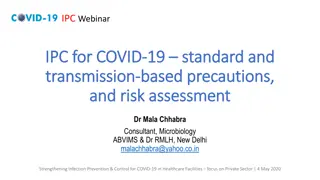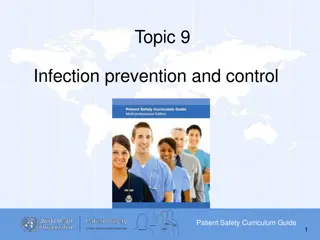Building a Business Case for Infection Prevention in Healthcare
Explore the essential reasons for a business case in infection prevention, focusing on market forces, economic viability, and the need to demonstrate value to healthcare administrators. Understand the critical role of infection control programs in healthcare facilities and the importance of cost efficiency in implementing effective strategies.
Download Presentation

Please find below an Image/Link to download the presentation.
The content on the website is provided AS IS for your information and personal use only. It may not be sold, licensed, or shared on other websites without obtaining consent from the author. Download presentation by click this link. If you encounter any issues during the download, it is possible that the publisher has removed the file from their server.
E N D
Presentation Transcript
Building a Business Case for Infection Prevention Thomas M Kerkering, MD, FACP, FIDSA Professor of Medicine and Chief, Section of Infectious Diseases, Medical director, Infection Control Virginia Tech Carilion School of Medicine and Carilion Clinic
Reasons for a Business Case ALTRUISM: Wish to prevent suffering & death - necessary & laudable goal, but does not pay the bills REALISM: Life s circumstances do not allow you to work for free PRAGMATISM: You need the resources to carry out an effective Infection Control Program
Number One Reason for a Business Case MARKET FORCES!! - Perhaps a bit cynical, but nevertheless true - The driving force behind the Epidemic of Infection Prevention is the decision by CMS to NOT REIMBURSE for potentially preventable events - Infection Prevention has now not only become necessary for the survival of the patient, but also for the survival of the facility
While society would benefit from a reduced incidence of nosocomial infections, there is currently no direct reimbursement to hospitals for the purpose of infection control, which forces healthcare institutions to make economic decisions about funding infection control activities. Demonstrating value to administrators is an increasingly important function of the hospital epidemiologist because healthcare executives are faced with many demands and shrinking budgets. Raising Standards While Watching the Bottom Line: Making a Business Case for Infection Control: Eli N. Perencevich, MD, MS; Patricia W. Stone, PhD, MPH, RN; Sharon B. Wright, MD, MPH; Yehuda Carmeli, MD, MPH; David N. Fisman, MD, MPH, FRCP(C); Sara E. Cosgrove, MD, MS Infect Control Hosp Epidemiol 2007; 28:1121-1133
Quiz: Find the one item in the Table below that is different from all of the others. The business of health care epidemiology: Creating a vision for service excellence Victoria J. Fraser, MD, Margaret A. Olsen, PhD, MPH, St Louis, Missouri AJIC: 30:2, April 2002
Basic Premise of an ICP Business Plan Infection Control Programs are not REVENUE PRODUCERS Infection Control Programs cost money The basis, or theme, of an Infection Control Business Plan is to demonstrate cost efficiency That is, an Infection Control Program will save more money than it costs to fund the Program.
A business case exists if the entity that invests in the intervention realizes a financial return on its investment in a reasonable time frame. The reasonable return can occur through profit, reduction in losses, or cost avoidance.* * Leatherman S, Berwick D, Iles D, et al. The business case for quality: case studies and an analysis. Health Aff (Millwood) 2003; 22:17-30.
Necessary Data for Initial Business Plan Number and type of HAIs over period of time (in- house) Attributable cost for each type of HAI (in- house or literature) Payor mix Listing of what CMS & other third party payors will not reimburse Personnel costs Equipment - computers - copiers - fax Software programs Space Supplies Communications Education (CME)
Attributable Cost Be forthright in explaining how you obtained (assumed) the attributable cost. Perform the calculations using the mean and the high and low ends of the range. Provide the literature.
References for Previous Table Dietrich ES, Demmler M, Schulgen G, et al. Nosocomial pneumonia: a cost-of-illness analysis. Infection 2002; 30:61-67. Hugonnet S, Eggimann P, Borst F, Maricot P, Chevrolet JC, Pittet D. Impact of ventilator-associated pneumonia on resource utilization and patient outcome. Infect Control Hosp Epidemiol 2004; 25:1090-1096. Warren DK, Shukla SJ, Olsen MA, et al. Outcome and attributable cost of ventilator-associated pneumonia among intensive care unit patients in a suburban medical center. Crit Care Med 2003; 31:1312-1317. Rello J, Ollendorf DA, Oster G, et al. Epidemiology and outcomes of ventilator-associated pneumonia in a large US database. Chest 2002; 122:2115-2121. Safdar N, Dezfulian C, Collard HR, Saint S. Clinical and economic con- sequences of ventilator-associated pneumonia: a systematic review. Crit Care Med 2005; 33:2184-2193. Blot SI, Depuydt P, Annemans L, et al. Clinical and economic outcomes in critically ill patients with nosocomial catheter- related bloodstream infections. Clin Infect Dis 2005; 41:1591-1598. Digiovine B, Chenoweth C, Watts C, Higgins M. The attributable mortality and costs of primary nosocomial bloodstream infections in the intensive care unit. Am J Respir Crit Care Med 1999; 160:976-981. Rello J, Ochagavia A, Sabanes E, et al. Evaluation of outcome of intra-venous catheter related infections in critically ill patients. Am J Respir Crit Care Med 2000; 162:1027-1030. Coello R, Charlett A, Wilson J, Ward V, Pearson A, Borriello P. Adverse impact of surgical site infections in English hospitals. J Hosp Infect 2005; 60:93-103. Coskun D, Aytac J, Aydinli A, Bayer A. Mortality rate, length of stay and extra cost of sternal surgical site infections following coronary artery bypass grafting in a private medical centre in Turkey. J Hosp Infect 2005;60:176-179. Hollenbeak CS, Murphy DM, Koenig S, Woodward RS, Dunagan WC, Fraser VJ. The clinical and economic impact of deep chest surgical site infections following coronary artery bypass graft surgery. Chest 2000; 118:397-402. Jenney AW, Harrington GA, Russo PL, Spelman DW. Cost of surgical site infections following coronary artery bypass surgery. ANZ J Surg 2001; 71:662-664. Tambyah PA, Knasinski V, Maki DG. The direct costs of nosocomial catheter-associated urinary tract infection in the era of managed care.Infect Control Hosp Epidemiol 2002; 23:27-31. Lai KK, Fontecchio SA. Use of silver-hydrogel urinary catheters on the incidence of catheter-associated urinary tract infections in hospitalized patients. Am J Infect Control 2002; 30:221-225.
http://www.cdc.gov/HAI/burden.html http://www.cdc.gov/HAI/burden.html
Infection Control Device Related Infections - Ventilators (VAP) - Central Lines (CLABSI) - Urinary Catheters (CAUTI) Multi Drug Resistant Organisms (MDRO) - MRSA - VRE - C diff - Gram negative bacilli Surgical Site Infections (SSI)
VAPs Hospital Wide Annual Vap Rate 12.0 10.1 10.0 10.8 8.0 6.0 4.9 4.0 2.0 1.3 0.0 FY 08 FY 09 FY 10 FY 11 Adult ICUs only Rate = (# VAPs / # ventilator days) X 1,000
Total FY VAP Costs $2,500,000 $1,967,052 $1,967,052 $2,000,000 $1,500,000 $1,026,288 $1,000,000 $342,096 $500,000 $0 FY2008 FY2009 FY2010 FY2011 VAP VAP VAP VAP
Year Attributable VAP Deaths Amount Saved from Prior Year FY2008 VAP 34 (69) FY2009 VAP 34 (69) 0 FY2010 VAP 18 (36) 16 FY2011 VAP 6 (12) 12 Potential Lives Saved 28
Total FY VAP Costs Amount Saved from Prior Year Year FY2008 VAP $1,967,052 FY2009 VAP $1,967,052 0 FY2010 VAP $1,026,288 $940,764 FY2011 VAP $342,096 $684,192 Total Savings $1,624,956
Year Total FY CLABSI Costs Amount Saved from Prior Year FY2008 CLABSI $1,224,552 FY2009 CLABSI $670,588 $553,964 FY2010 CLABSI $728,900 ($58,312) FY2011 CLABSI $699,744 $29,156 Total Savings $524,808
Year Total FY CAUTI Costs Amount Saved from Prior Year FY2008 CAUTI $106,742 - $173,204 $55,385 FY2009 CAUTI $51,357 FY2010 CAUTI $29,203 $22,154 FY2011 CAUTI $10,070 $19,133 Total Savings $96,672
Devices Savings over 3 Yr. Period VAPs CLABSIs CAUTIs Sub total $1,624,956 $524,808 $96,672 $2,246,436 MDROs MRSA VRE C diff Gram negative bacilli Sub total SSIs CABG Colon KNPRO HPRO HYST Sub total GRAND TOTAL
Item Each $82,280 Number Cost/year 3 Year Cost 6 $493,680 $1,481,040 Personnel Costs (Salary + Benefits) Equipment Computers $1,100 6 $6,600 Copier/Fax (rent with maintenance agreement) Software License 1 2 $1,750 $60,000 $1,750 $180,000 Space (rent) $36,000 $108,000 Supplies $5,000 $15,000 Communications (telephone, beepers, postage) $6,000 $18,000 Education (CME, Dues, Journals) $8,000 $24,000 TOTAL $1,834,390
Device Savings Program Costs Net Gain $2,246,436 $1,834,390 $412,046 Assume 3 year Savings MDROs SSIs $150,000 $200,000 Total 3 Year Net Gain $762,046 Program Costs already incorporated for MDRO s & SSI s
STEPS FOR DEVELOPING A BUSINESS CASE/PLAN
1. Develop a Mission Statement Improve patient morbidity and mortality by reducing hospital acquired infections through (cost effective) evidence based practices - make sure it is in line with the mission of the facility - keep it simple and defensible - it becomes your Constitution - one can always refer to the Mission Statement to keep the program on track
2. Frame the Problem and Develop a Hypothesis About Potential Solutions The problem is HAIs and their economic costs to the facility Use your data (shown in previous slides) to demonstrate the costs Determine which interventions would be necessary to reduce HAIs Determine the resources needed Develop a budget based on this
3. Meet With Key Administrators Director of Quality Improvement, Chief Medical Officer, Chief Financial Officer - Obtain agreement that this is of institutional concern & has the support of hospital leadership - Learn from this meeting who else within the facility are key players and who should be included in developing the business plan - Learn of other costs to consider in the plan
4. Determine the Annual Costs Personnel costs Equipment - computers - copiers - fax Software programs Space Supplies Communications Education (CME)
5. Determine What Costs Can Be Avoided Through Reduced Infection Rates From your surveillance data determine the number of infections you are experiencing in each of the categories surveyed (devices, MDROs, SSIs) Decide what you are going to target
6. Determine the Costs Associated With the Infection of Interest at Your Hospital If your institution can do this, determine the costs associated with each device infection, SSI and MDRO Otherwise, use the literature (which to choose?) Some software can do this for a price (Med Mined) The number reduced X the associated cost = the savings in that period of time (not really)
This is where it gets tricky: One has to use attributable costs If, for an example, the cost of a particular HAI is $10,000, the hospital does not necessarily lose $10,000 for each of these HAIs The reason is because a certain percentage of these costs are still reimbursed by 3rd Party Payors. Factoring in the Payor mix and the percentage reimbursed leads to the attributable cost
EXAMPLE Assume that the cost of a CLABSI is $25,000 In your plan you have decided that you will prevent 10 CLABSIs. The bad logic is the calculation that 10 X $25,000 = $250,000 & since you cost $80,000 you saved the hospital $170,000. The finance people will say, Not so fast If the profit from a patient with a central line is $10,000, but with an identical patient with a CLABSI this falls to $1,000 (because of a mix of reimbursements), the savings per CLABSI prevented is $9,000, not $25,000. The total amount for 10 patients is $90,000. You cost $80,000. The real savings for the hospital is $10,000 STAY TUNED
7. Now Calculate the Financial Impact Do it for each type of HAI you are trying to prevent Calculate three ways using the mean, low end and high end attributable cost. The result will be a range Subtracting the costs of the Program The result is the anticipated savings
8. Include all Financial Benefits Do it for each type of HAI you are trying to prevent - Devices (CAUTI, CLABSI, VAP - SSIs (KPRO, HPRO, CABG, Colon, Hyst, etc.) - MDROs (MRSA, VRE, C diff, gram negative bacilli
9. Make Your Case Do not immediately take your plan to the highest of the high Discuss it with unit managers, various vice- presidents, department managers, etc. Tweak, build consensus Get ideas for the implementation plan Now you are ready Dooley RS, Fryxell GE, Judge WQ. Belaboring the not-so-obvious: consensus, commitment, and strategy implementation speed and success. J Management 2000; 26:1237-1257.
10. Never Stop Collecting Cost & Outcome Data Imperative to show what has occurred after an intervention Once HAIs become low, rate of savings return lessens Administrators may think of cutting budget Use this data to show what could happen without a continued program
Cost-effectiveness analysis. Cost-effectiveness analysis compares interventions or products that have different costs and different levels of effectiveness. The benefits of an intervention are measured, such as the number of lives saved or infections prevented. Programs are then compared in terms of cost per unit (e.g., dollars per life-year gained or dollars per infection prevented). Cost-utility analysis. The benefits of a specific intervention are adjusted by health preference scores or are utility weighted. In this type of analysis, programs are compared in terms of quality-adjusted life-years (QALYs) gained. Cost-benefit analysis. One in which all aspects of the analysis, including the consequences of the intervention, are valued in monetary or dollar terms. If an intervention s benefits measured in dollars exceed its costs, then this analysis considers it worthwhile. The major impediment to the use of cost-benefit analysis in healthcare decision making is the requirement to set a monetary value on human life or health benefits. Drummond MF, Sculpher MJ, Torrance GW, O Brien BJ, Stoddart GL. Methods for the Economic Evaluation of Health Care Programmes. 7th ed. Oxford: Oxford University Press; 2005.
Raising Standards While Watching the Bottom Line: Making a Business Case for Infection Control: Eli N. Perencevich, MD, MS; Patricia W. Stone, PhD, MPH, RN; Sharon B. Wright, MD, MPH; Yehuda Carmeli, MD, MPH; David N. Fisman, MD, MPH, FRCP(C); Sara E. Cosgrove, MD, MS Infect Control Hosp Epidemiol 2007; 28:1121-1133
More on Attributable Costs Measure it for your institution E.g., MRSA SSI: - Cases with MRSA SSI - Cases without MRSA SSI - Minimum match - prior length of stay - co-morbid conditions - severity of illness This is a Cohort Study
Cases of HFOHFA C difficile at Hospital X October 2010 through April 2011 = 50
Group Controls Cases Mean 1.5700 3.0000 SD 1.4100 1.7800 SEM 0.2940 0.3712 N 23 23 P value and statistical significance: The two-tailed P value equals 0.0042 Confidence interval: The mean of Controls minus Cases equals -1.4300 95% confidence interval of this difference: From -2.3843 to -0.4757 Intermediate values used in calculations: t = 3.0201 df = 44 standard error of difference = 0.473
Summary Your Infection Control Program Needs to have built a business case Simply stating, We do good work by reducing infections and saving lives will not generate resources Prove it with your data and the literature
Necessary Data for Initial Business Plan Number and type of HAIs over period of time (in- house) Attributable cost for each type of HAI (in- house or literature) Payor mix Listing of what CMS & other third party payors will not reimburse Personnel costs Equipment - computers - copiers - fax Software programs Space Supplies Communications Education (CME)
Summary Patience Knowledge of how to use a spreadsheet Ask for help - finance administrator - epidemiologist/statistician/economist
Summary With today s climate and emphasis on safety, quality, and cost containment Infection Control has come of age. It is an exciting time!



